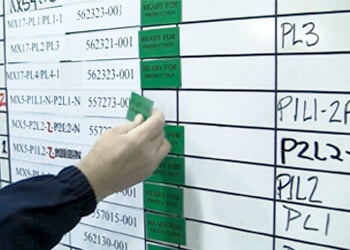Resource Navigation
Obeya in the Workplace: An Overview
03
February,
2023
3 MINUTE READ

At its core, "obeya" (Japanese for "big room" or "great room") is a lean manufacturing tool, in which a dedicated room is set aside for employees to meet and make decisions about a specific topic or problem. It sounds like a small change-what workplace doesn't have some kind of meeting room, after all?-but a dedicated obeya can have far-reaching impacts in the workplace that enhance productivity, save money, increase efficiency, and improve communication.
In this article, we'll look at the basics of obeya, how facilities can implement it in their workplace, and how Duralabel can assist those efforts.
What Is an Obeya?
An obeya is a room set up to get employees out of their offices and cubicles and into a central location where they can meet, discuss key information, and solve pressing problems. The idea behind an obeya is to break down the barriers that prevent employees from collaborating and sharing information to make efficient decisions. Obeyas are most effective when established and outfitted to solve singular problems or work on specific projects. Ideally, they host an array of visual information to make the process smoother and more efficient, as well.
For instance, a company looking to boost warehouse safety may gather engineers to discuss new equipment, safety managers to review ongoing safety concerns, warehouse workers to discuss challenges on the working floor, and human resources representatives to analyze and communicate new policies. This obeya might host charts, images, maps, and more to convey the concerns, along with whiteboards and other collaborative materials that allow employees to find solutions together.
An obeya is typically open to all relevant employees and groups for meetings and discussion. Some companies might schedule daily meetings for quick updates; others hash things out in longer, weekly (or monthly) meetings; and, on occasion, companies might use an obeya for impromptu updates. Project managers may even have their desks temporarily located there.
What Is Needed in an Obeya?
Given that every company is different, no two obeyas look alike. But a few elements common to obeyas include:
- Charts, graphs, and drawings (which usually depict a project's progress, milestones, timing, schedules and other timely data)
- Desks and/or tables for project leaders
- Anything else a company needs to facilitate strategic problem-solving, including real-time displays, computer systems, and more
Better Problem-Solving with Obeya and PDCA

An obeya promotes quicker, more nimble problem-solving by speeding up the Plan-Do-Check-Act (PDCA) process.
Here's a breakdown of the PDCA cycle:
- Plan: Define a problem and develop potential solutions.
- Do: Implement a proposed solution.
- Check: Evaluate the results to see whether a solution is working.
- Act: Take one of two actions: return to the planning step if the results aren't satisfactory, or standardize the solution if the results are sufficient.
Rather than communicating across departments over the course of days or weeks, an obeya brings together key decision-makers to implement the PDCA cycle and develop solutions quickly.
Benefits to Using an Obeya
Companies using an obeya may enjoy a number of benefits. Those include:
- Efficiency: A project's leadership team can save time by bringing helpful visuals, necessary information, and vital resources together in one place
- Focus: Having key team members in the same room for collaboration and discussion means that project leaders can focus on the right issues
- Collaboration: An obeya fosters an environment in which employees can work together across disciplines and in real-time, rather than via e-mail or in rushed meetings
What's the Relationship Between Obeya and Toyota?
Toyota has used the Obeya approach as an integral project-management tool, especially in product development, to improve and streamline communication. Similar in concept to traditional "war rooms," an obeya typically contains visual charts and graphs depicting program timing, milestones, progress to date, and countermeasures to existing timing or technical problems. Project leaders may sit at desks in the obeya, as will others at appropriate points in the program timing.
Given its emphasis on improving communication and boosting efficiency, it's no surprise that obeya is one of the pillars of the Toyota Production System. (Other elements of the Toyota Production System include 5S, Kaizen, Kanban, Total Productive Maintenance, and the visual factory concept.)
Lean manufacturing, an integral part of the Toyota Production System, focuses on eliminating waste and standardizing workflows, processes, and procedures throughout a facility. Toyota used the tools to become one of the most-admired car companies in the world.
Obeya facilitates effective and timely communication at Toyota, without resorting to arduous meetings, never-ending email chains, and laborious decision-making processes. It is especially useful during the product development phase, when employees congregate to discuss design differences, engineering concerns, progress milestones, and more.
Developing an Obeya
Labeling, signage, and visual communication are key components of an effective obeya. Posters, charts, labels, and signs can help employees visualize and understand information quickly.
DuraLabel industrial label and sign printers by Duralabel can assist in developing clear, impactful custom visual communication for numerous applications. DuraLabel printers are compatible with a variety of materials, including magnetic and static cling materials, which allow workers to reorganize charts and plans over the course of their discussions.
Echo large-format poster printer and enlarger by Duralabel gives you posters and charts that can be read from across the room-on demand, using low-cost and recyclable paper supplies. With Echo, you can create 5S shadow boards, safety notifications, diagram outlines, progress charts, facility achievements, goals, and more.
RELATED RESOURCES

Five Ways to Meet OSHA Requirements for Safety Signage
Every day, American workers service high-powered equipment, build and fix roads, and manufacture the goods we ...
Read
A3 Problem Solving
What is A3, and what does it have to do with problem solving? A3 is a standard paper size, roughly 11"x17" - ...
Read
OSHA Floor Marking Guide
Modern workplaces, however safe they may be, are fraught with hazards. Forklifts, energized equipment, ...
Read.png)


